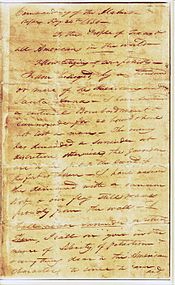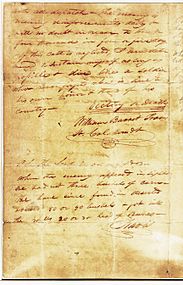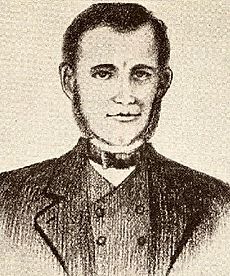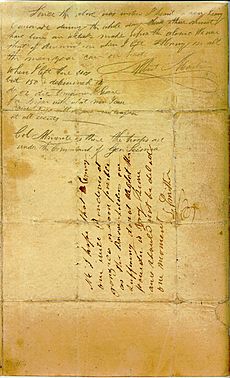- This page was last modified on 17 October 2025, at 10:18. Suggest an edit.
To the People of Texas & All Americans in the World facts for kids
Travis's letter
The first page of William Barret Travis's letter, To the People of Texas & All Americans in the World
To the People of Texas & All Americans in the World is a famous open letter written on February 24, 1836. It was written by William B. Travis, who was the commander of the Texan soldiers at the Battle of the Alamo. He wrote it to people living in Mexican Texas. This letter is known as a strong "declaration of defiance" and a "masterpiece of American patriotism." It is a very important part of Texas history taught to schoolchildren.
On February 23, 1836, the Alamo Mission in San Antonio, Texas was surrounded by Mexican forces. These forces were led by General Antonio López de Santa Anna. Travis worried that his small group of men could not fight off such a large army. So, he wrote this letter asking for more soldiers and supplies from people who supported their cause. The letter ends with Travis's famous promise: "Victory or Death!" This powerful phrase has been both praised and discussed by historians.
The letter was first given to a messenger named Albert Martin. He carried it to the town of Gonzales, which was about seventy miles away. Martin added his own notes to the letter, asking men to hurry and help the Alamo. Then, he gave the letter to Launcelot Smithers. Smithers also added a note and delivered the letter to its main destination, San Felipe de Austin. Local printers made over 700 copies of the letter. It also appeared in the two main Texas newspapers. Eventually, it was printed all over the United States and Europe. Because of this letter, men from Texas and the United States started gathering in Gonzales. Between 32 and 90 of these men reached the Alamo before it fell. The rest of the men became the start of the army that later defeated Santa Anna at the Battle of San Jacinto.
After the Texas Revolution ended, the original letter was given to Travis's family in Alabama. In 1893, one of his family members sold it to the State of Texas for $85 ($2,768 today). For many years, it was shown at the Texas State Library. Now, the original letter is kept in a dark place to protect it. What you see on display today is an exact copy. It is shown with a picture of Travis.
Contents
Why the Letter Was Written
In 1824, Mexico changed its laws to let foreigners settle in areas like Mexican Texas. Many people moved there. By 1834, about 30,000 English-speaking people, mostly from the United States, lived in Texas. One of these immigrants was William Barret Travis. He was from Alabama and had worked as a teacher, newspaper publisher, and lawyer.
Travis was a strong supporter of states having more power, rather than a strong central government. In 1835, the Mexican president, Antonio López de Santa Anna, started taking more power for himself. This led to rebellions in several Mexican states. Travis led an attack in June 1835 and made the Mexican soldiers there surrender. Many Texans thought this was a bit reckless.
Texans became more and more unhappy with the government. In October, the Texas Revolution began. Travis joined the new Texan army. By the end of 1835, all Mexican troops had left Texas. Many Texans thought the war was over and went home.
However, rumors spread that Santa Anna would personally lead an invasion of Texas. Even with this news, the Texan army kept getting smaller. Texans were also divided on what they were fighting for: independence or just a return to a federalist government in Mexico. This confusion made many settlers stay home. Fewer than 100 Texan soldiers remained at the Alamo Mission in San Antonio, Texas. Their commander, James C. Neill, worried his small group could not stop a Mexican attack. Governor Henry Smith sent Travis and 30 men to the Alamo. They arrived on February 3, 1836. Most Texans, including Travis, thought any Mexican invasion was still months away.
Writing the Famous Letter
Travis took command of the Alamo on February 11, 1836. On February 23, Santa Anna arrived in San Antonio with about 1500 Mexican soldiers. The 150 Texan soldiers were not ready for this. They quickly brought cattle into the Alamo and looked for food in nearby houses. The Mexican army began to surround the Alamo. They raised a blood-red flag, which meant they would show no mercy. Travis fired the Alamo's largest cannon in response.
The first night of the siege was mostly quiet. The next afternoon, Mexican cannons started firing at the Alamo. One Mexican officer wrote that two of the Alamo's cannons were knocked down. But the Texans quickly put them back in action. Soon after, Travis wrote his famous open letter asking for help from "the people of Texas & All Americans in the World."
Here is what Travis wrote:
To the People of Texas & All Americans in the World:
Fellow citizens & compatriots—I am besieged, by a thousand or more of the Mexicans under Santa Anna—I have sustained a continual Bombardment & cannonade for 24 hours & have not lost a man. The enemy has demanded a surrender at discretion, otherwise, the garrison are to be put to the sword, if the fort is taken—I have answered the demand with a cannon shot, & our flag still waves proudly from the walls. I shall never surrender or retreat. Then, I call on you in the name of Liberty, of patriotism & everything dear to the American character, to come to our aid, with all dispatch—The enemy is receiving reinforcements daily & will no doubt increase to three or four thousand in four or five days. If this call is neglected, I am determined to sustain myself as long as possible & die like a soldier who never forgets what is due to his own honor & that of his country—Victory or Death.
William Barret Travis
Lt. Col. comdt
P.S. The Lord is on our side—When the enemy appeared in sight we had not three bushels of corn—We have since found in deserted houses 80 or 90 bushels & got into the walls 20 or 30 head of Beeves.
Travis
How the Letter Spread
Travis gave the letter to a messenger named Albert Martin. Martin rode through the night to cover the 70 miles (110 km) to Gonzales as fast as he could. During his ride, Martin added two notes to the letter. The first note said he feared the Mexican army had already attacked the Alamo and ended with "Hurry on all the men you can in haste." The second note was harder to read but said the men at the Alamo were "determined to do or die." Martin planned to gather help and return quickly.
In Gonzales, Martin gave the letter to Launcelot Smithers. Smithers had left San Antonio when the Mexican army arrived. He added his own message below Martin's, urging men to gather in Gonzales to help the Texans at the Alamo.
Smithers then rode quickly and delivered Travis's letter to San Felipe de Austin in less than 40 hours. In a quick meeting, town leaders promised to help the Alamo defenders. The results of the meeting were printed on a large paper (a broadsheet) along with a copy of Travis's letter. Publishers Joseph Baker and Thomas Borden made over 700 copies in total. Their last printing included a message from Governor Henry Smith. He urged colonists "to fly to the aid of your besieged countrymen and not permit them to be massacred." He said, "The call is upon ALL who are able to bear arms, to rally without one moment's delay." The letter was also printed in major Texas newspapers and later throughout the United States and Europe.
Keeping the Letter Safe
After the Texas Revolution, the original letter was given to Travis's family in Alabama. Travis's daughter, Susan, passed the letter down to her family. It eventually reached her great-grandson, John G. Davidson. In 1891, Davidson lent the letter to the Texas Department of Agriculture. Two years later, he offered to sell it to the state of Texas for $250 ($8,143 today). After some talks, Davidson agreed to sell it for $85 ($2,768 today), and the state officially bought it on May 29, 1893.
For many years, the letter was shown to the public, usually in a glass case with other items from the Texas Revolution. In 1909, the letter moved to the Texas State Library. It has only left that building twice since then for special events. The original letter is no longer always on display. Instead, there is a very exact copy. A portrait of Travis hangs right above its display case.
The Letter Returns to the Alamo
In October 2012, the Texas General Land Office announced that the famous Travis Letter would be displayed at the Alamo. This happened from February 23 to March 7, 2013. This was the first time the important letter had returned to the Alamo since Travis wrote it. The display was free for everyone to see.
See also
 In Spanish: Para las personas de Texas y todos los americanos en el mundo para niños
In Spanish: Para las personas de Texas y todos los americanos en el mundo para niños




